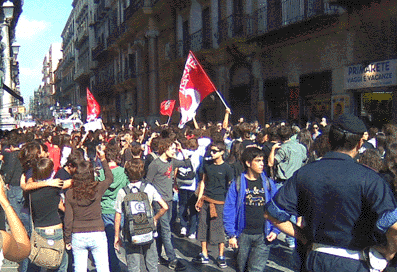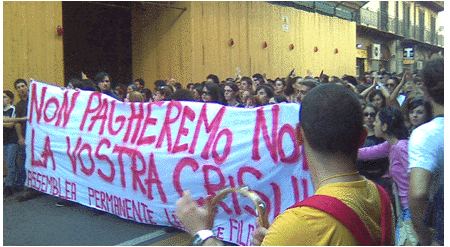...Best of Sicily presents... Best of Sicily Magazine. ... Dedicated to Sicilian art, culture, history, people, places and all things Sicilian. |
by Manlio Lima | ||
Magazine Index Best of Sicily Arts & Culture Fashion Food & Wine History & Society About Us Travel Faqs Contact Map of Sicily
|
Who are these people? They may be disgruntled workers, people seeking work, or students who'd prefer not to work today. So that a weekend (not working) can be extended, protests and strikes are almost invariably planned for Friday or Monday. Not to worry, however, as the "revolution" usually breaks for lunch or dinner. In the meantime buses stop circulating around most of the city, shops cease to accomodate customers and pedestrians are invited to participate. The provincial prefect and police are only too happy to accomodate the protesters. How did we arrive at this point? When did strikes and disorder become the order of the day in Italy? The young people (recent student protests against education ministry reforms are shown on this page) imitate their elders, who take every opportunity to close down a city or even the entire country. The student equivalent of a strike is a sit-in ("occupazione" or "permanent assembly") several classrooms or lecture halls of a high school or university, closing down an entire institution. The police, on orders of their superiors, simply stand by and watch; the government authorities are reluctant to act for fears of accusations of brutality or "fascism." The situation makes Italy a laughingstock.
The only way to describe the situation is to say, by way of observation, that when it comes to popular discontent --based on real or imaginary problems-- Italy is essentially a lawless land where anything goes. Too many Italians are undisciplined and the protests and strikes rarely solve anything. Some are rooted in the ridiculous. The recent (October 2008) student protests are a case in point. University fees in Italy average around 400 euros (300 US dollars) per year, with books costing around fifty euros per course. Inexpensive as this is, the students complained about proposed increases, as well as staff cutbacks and the introduction of a more rigid admissions policy (as opposed to the present "open" admissions). Because the typical student at the University of Palermo is "fuori corso," taking seven or eight years to complete a three or four year degree programme, he or she must pay the fees for each year of enrollment. That's the real problem: paying for seven years when the student should be paying for three or four (five in the medical schools). These are young adults who live with parents until the age of 30 or 40 without seeking even part-time employment. Granted, student life in Sicily leaves much to be desired, but the protests achieve nothing. It's almost impossible to fire incompetent faculty and staff, so little will have changed following the protests and sit-ins. In the workplace, relations between management and employees remain adversarial after decades of democracy in Italy. In the public sector employees have protested recent measures against "fannuloni," the "do-nothings" who routinely fail to show up at their places of employment three or four days each month. What gives Italians the right to close off public streets whenever they wish? In theory, the province's police prefect exercises discretion over who is permitted to protest in this way. In practice, such permission is rarely denied. In principle, these rights are protected by the leftish Italian constitution ratified in 1948 as a reaction to almost a quarter-century of Fascism following Italy's existence as a monarchical police state for at least six decades before that. Still, one wonders if things might not have become too permissive. The economy of Italy, and particularly Sicily, is in terrible shape. The protests and strikes only make matters worse. About the Author: Manlio Lima has written on law, history and other topics for various Italian magazines. | |
Top of Page |
 You're spending a tranquil Friday morning sightseeing in historic Palermo or Catania when, as if out of the blue, a
police patrol begins blocking the busy street. You wonder what is going on. Could it be a roadblock meant to apprehend a
fleeing criminal? Listening, you hear distant noise that seems to be getting nearer. A few minutes pass, traffic
detouring around the impromptu barricade, and the noise is less faint as it gets nearer. You begin to wonder if a riot
is in progress, and if you should be worried. Then, around a corner bursts a chaotic, unkempt mob. Whistles are blowing,
loud music is playing, indecipherable phrases are being shouted and plenty of banners and red flags are in evidence.
You've happened upon that most frequent of populist Sicilian urban phenomena: the street protest!
You're spending a tranquil Friday morning sightseeing in historic Palermo or Catania when, as if out of the blue, a
police patrol begins blocking the busy street. You wonder what is going on. Could it be a roadblock meant to apprehend a
fleeing criminal? Listening, you hear distant noise that seems to be getting nearer. A few minutes pass, traffic
detouring around the impromptu barricade, and the noise is less faint as it gets nearer. You begin to wonder if a riot
is in progress, and if you should be worried. Then, around a corner bursts a chaotic, unkempt mob. Whistles are blowing,
loud music is playing, indecipherable phrases are being shouted and plenty of banners and red flags are in evidence.
You've happened upon that most frequent of populist Sicilian urban phenomena: the street protest! Where adults are concerned,
protests are only part of the mix because actual labour strikes are usually involved (Alitalia and the rail service are infamous for this). In late 2007
truckers blocked important highways (autostrade) for a week, making food deliveries to supermarkets difficult, while the nation's president
and prime minister stood by inactively and unresponsively.
Where adults are concerned,
protests are only part of the mix because actual labour strikes are usually involved (Alitalia and the rail service are infamous for this). In late 2007
truckers blocked important highways (autostrade) for a week, making food deliveries to supermarkets difficult, while the nation's president
and prime minister stood by inactively and unresponsively.